Case Study Analysis: Delta Airlines Marketing Strategies and Analysis
VerifiedAdded on 2020/03/16
|21
|5235
|96
Case Study
AI Summary
This case study provides a comprehensive analysis of Delta Airlines, examining its business environment, marketing strategies, and the impact of globalization. The report begins with an executive summary and table of contents, followed by an introduction to the airline industry and a background on Delta. It then delves into a PESTEL analysis, evaluating the political, economic, social, technological, environmental, and legal factors affecting Delta. The study explores the impact of globalization on stakeholders and employs the VRIO framework to assess Delta's resources. Porter's Five Forces are used to analyze industry competition, including bargaining power of buyers and suppliers, and the threat of new entrants and substitutes. A SWOT analysis is presented, followed by an examination of globalization's effect on Delta's corporate strategy. The report concludes with a summary of findings and references. The analysis covers market size, competitive rivalry, development patterns, and distribution channels, offering valuable insights into Delta's strategic positioning and future trends.
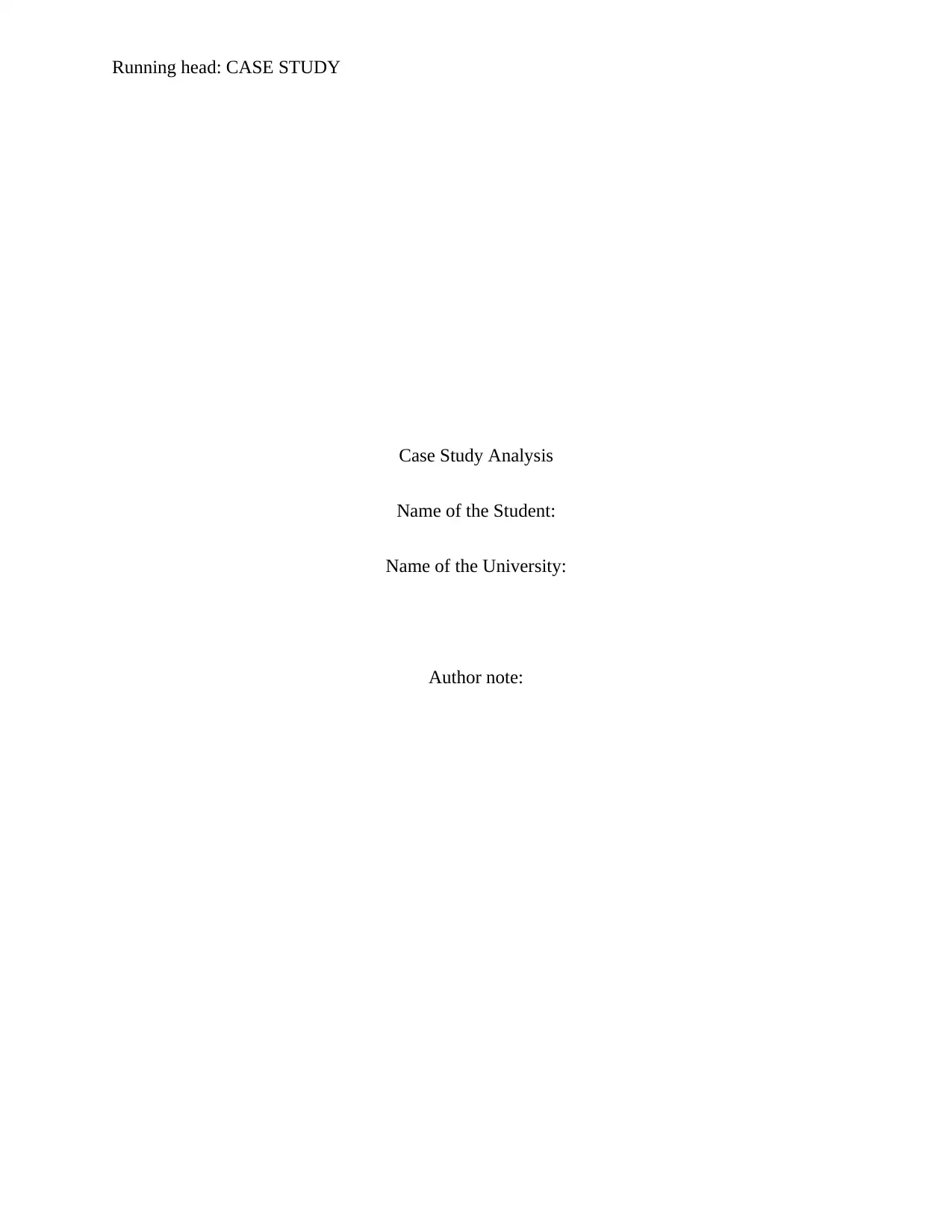
Running head: CASE STUDY
Case Study Analysis
Name of the Student:
Name of the University:
Author note:
Case Study Analysis
Name of the Student:
Name of the University:
Author note:
Paraphrase This Document
Need a fresh take? Get an instant paraphrase of this document with our AI Paraphraser
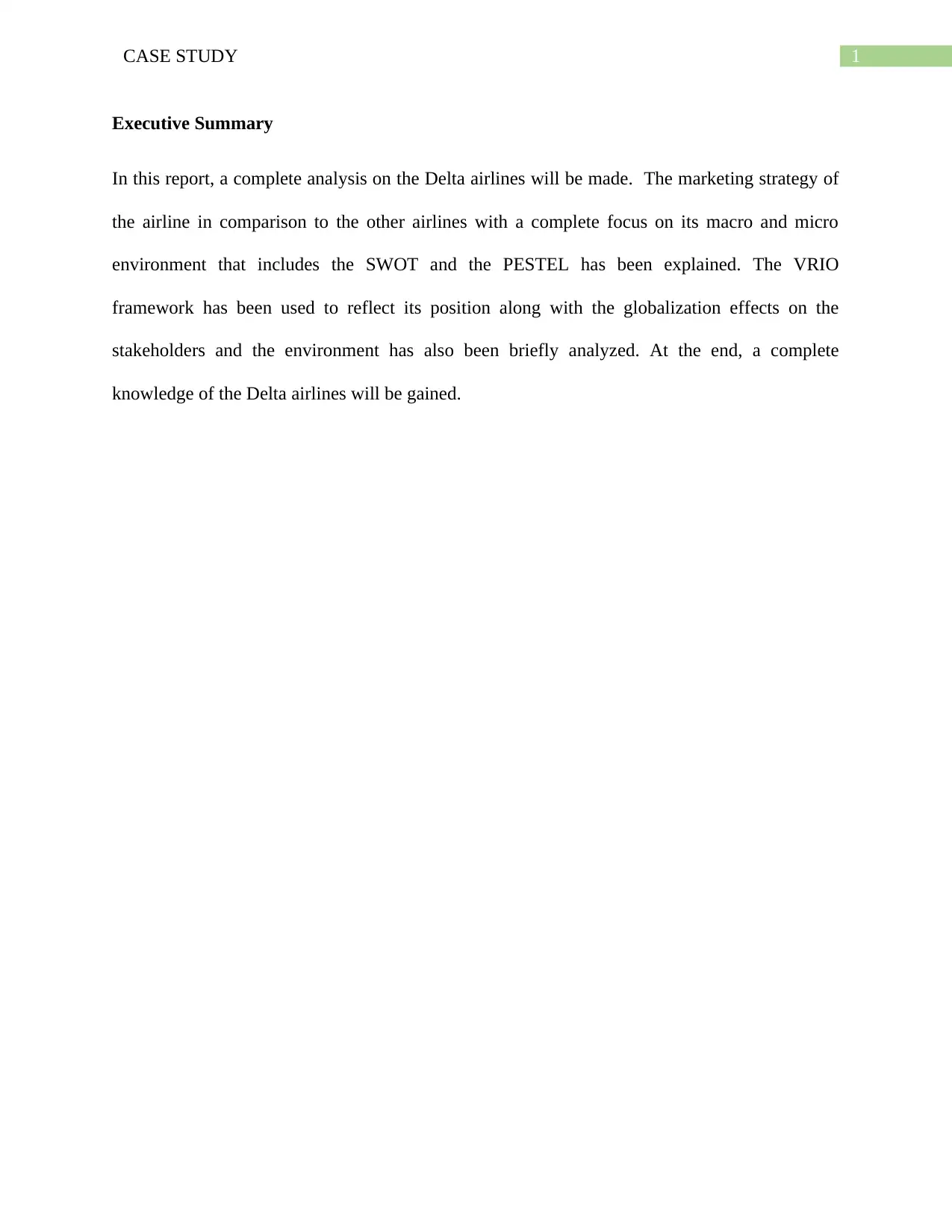
1CASE STUDY
Executive Summary
In this report, a complete analysis on the Delta airlines will be made. The marketing strategy of
the airline in comparison to the other airlines with a complete focus on its macro and micro
environment that includes the SWOT and the PESTEL has been explained. The VRIO
framework has been used to reflect its position along with the globalization effects on the
stakeholders and the environment has also been briefly analyzed. At the end, a complete
knowledge of the Delta airlines will be gained.
Executive Summary
In this report, a complete analysis on the Delta airlines will be made. The marketing strategy of
the airline in comparison to the other airlines with a complete focus on its macro and micro
environment that includes the SWOT and the PESTEL has been explained. The VRIO
framework has been used to reflect its position along with the globalization effects on the
stakeholders and the environment has also been briefly analyzed. At the end, a complete
knowledge of the Delta airlines will be gained.
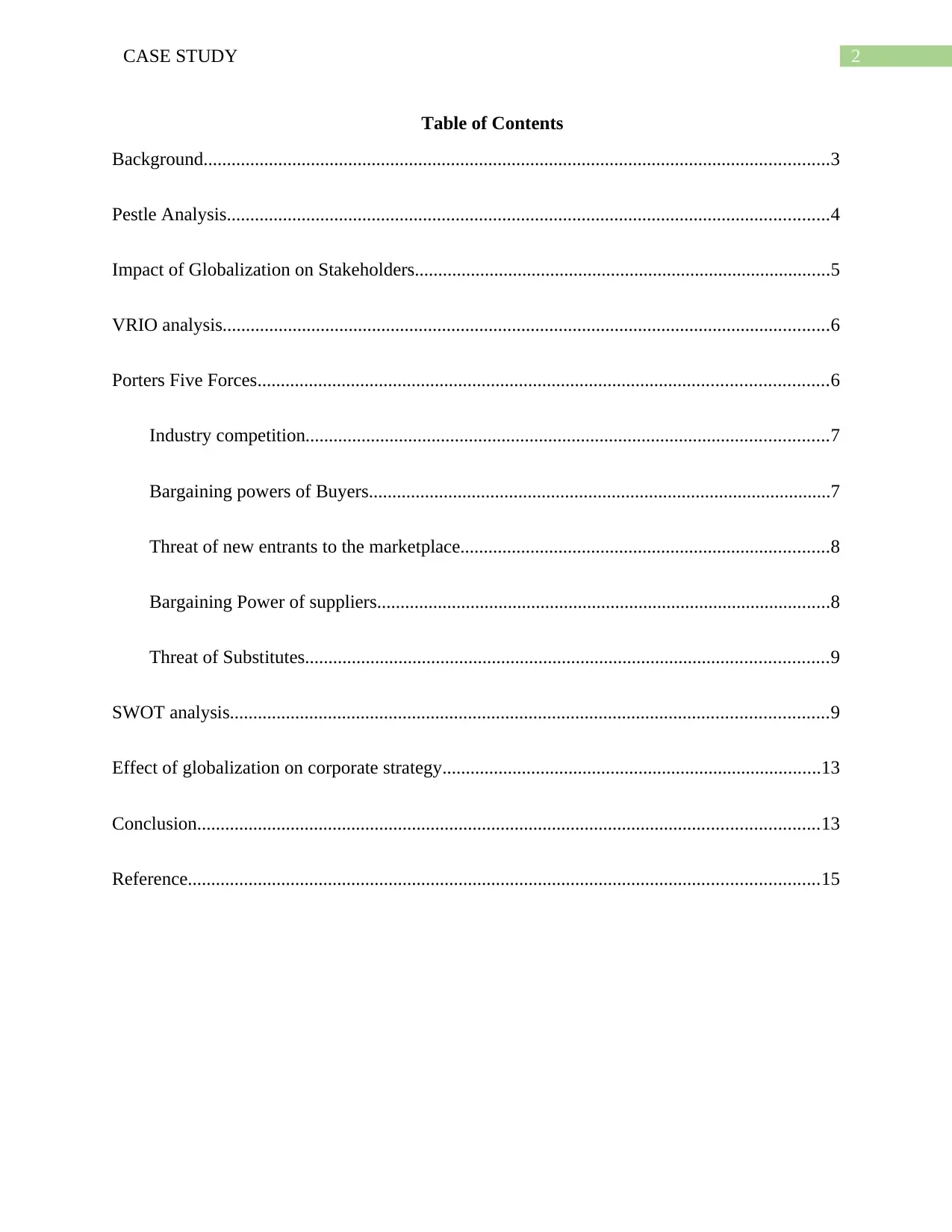
2CASE STUDY
Table of Contents
Background......................................................................................................................................3
Pestle Analysis.................................................................................................................................4
Impact of Globalization on Stakeholders.........................................................................................5
VRIO analysis..................................................................................................................................6
Porters Five Forces..........................................................................................................................6
Industry competition................................................................................................................7
Bargaining powers of Buyers...................................................................................................7
Threat of new entrants to the marketplace...............................................................................8
Bargaining Power of suppliers.................................................................................................8
Threat of Substitutes................................................................................................................9
SWOT analysis................................................................................................................................9
Effect of globalization on corporate strategy.................................................................................13
Conclusion.....................................................................................................................................13
Reference.......................................................................................................................................15
Table of Contents
Background......................................................................................................................................3
Pestle Analysis.................................................................................................................................4
Impact of Globalization on Stakeholders.........................................................................................5
VRIO analysis..................................................................................................................................6
Porters Five Forces..........................................................................................................................6
Industry competition................................................................................................................7
Bargaining powers of Buyers...................................................................................................7
Threat of new entrants to the marketplace...............................................................................8
Bargaining Power of suppliers.................................................................................................8
Threat of Substitutes................................................................................................................9
SWOT analysis................................................................................................................................9
Effect of globalization on corporate strategy.................................................................................13
Conclusion.....................................................................................................................................13
Reference.......................................................................................................................................15
⊘ This is a preview!⊘
Do you want full access?
Subscribe today to unlock all pages.

Trusted by 1+ million students worldwide
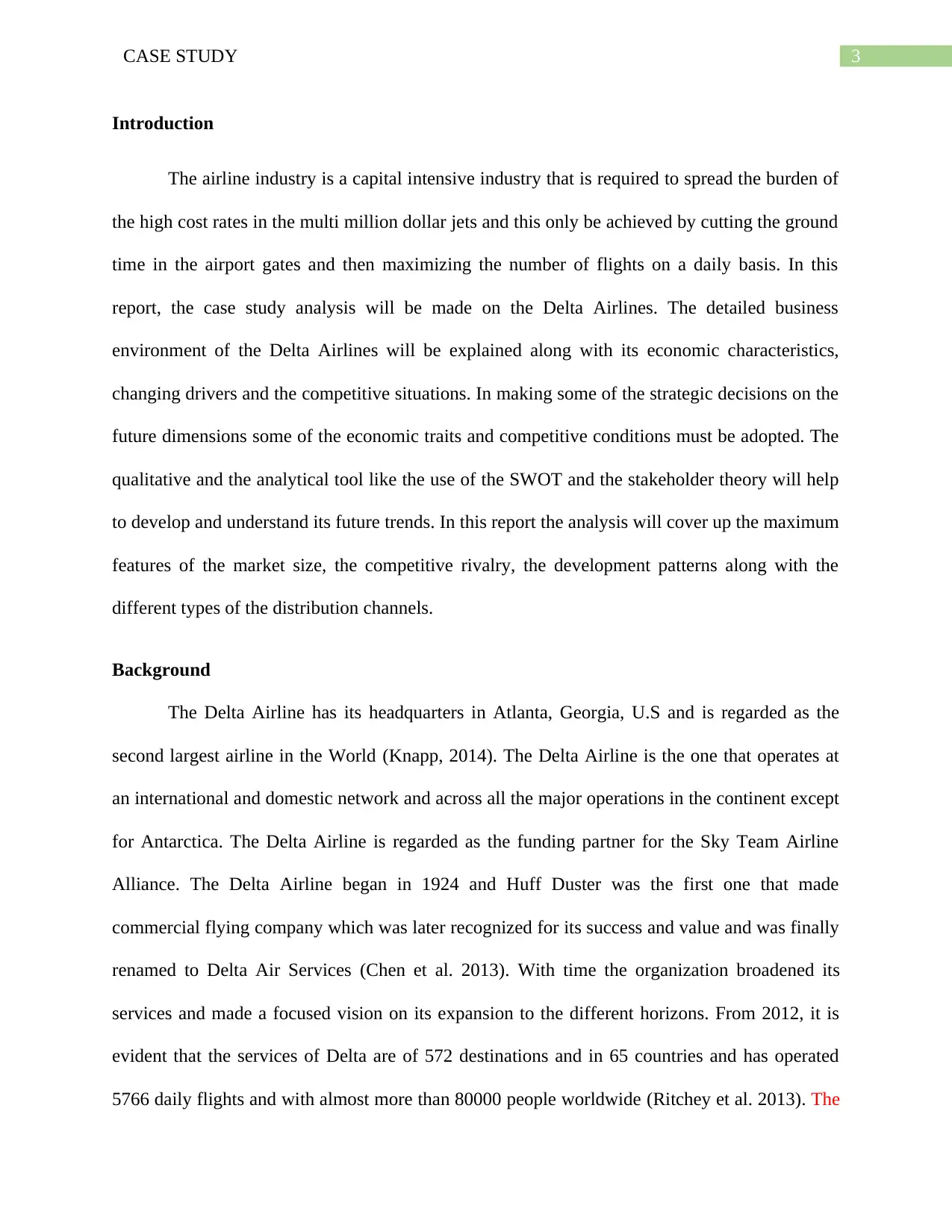
3CASE STUDY
Introduction
The airline industry is a capital intensive industry that is required to spread the burden of
the high cost rates in the multi million dollar jets and this only be achieved by cutting the ground
time in the airport gates and then maximizing the number of flights on a daily basis. In this
report, the case study analysis will be made on the Delta Airlines. The detailed business
environment of the Delta Airlines will be explained along with its economic characteristics,
changing drivers and the competitive situations. In making some of the strategic decisions on the
future dimensions some of the economic traits and competitive conditions must be adopted. The
qualitative and the analytical tool like the use of the SWOT and the stakeholder theory will help
to develop and understand its future trends. In this report the analysis will cover up the maximum
features of the market size, the competitive rivalry, the development patterns along with the
different types of the distribution channels.
Background
The Delta Airline has its headquarters in Atlanta, Georgia, U.S and is regarded as the
second largest airline in the World (Knapp, 2014). The Delta Airline is the one that operates at
an international and domestic network and across all the major operations in the continent except
for Antarctica. The Delta Airline is regarded as the funding partner for the Sky Team Airline
Alliance. The Delta Airline began in 1924 and Huff Duster was the first one that made
commercial flying company which was later recognized for its success and value and was finally
renamed to Delta Air Services (Chen et al. 2013). With time the organization broadened its
services and made a focused vision on its expansion to the different horizons. From 2012, it is
evident that the services of Delta are of 572 destinations and in 65 countries and has operated
5766 daily flights and with almost more than 80000 people worldwide (Ritchey et al. 2013). The
Introduction
The airline industry is a capital intensive industry that is required to spread the burden of
the high cost rates in the multi million dollar jets and this only be achieved by cutting the ground
time in the airport gates and then maximizing the number of flights on a daily basis. In this
report, the case study analysis will be made on the Delta Airlines. The detailed business
environment of the Delta Airlines will be explained along with its economic characteristics,
changing drivers and the competitive situations. In making some of the strategic decisions on the
future dimensions some of the economic traits and competitive conditions must be adopted. The
qualitative and the analytical tool like the use of the SWOT and the stakeholder theory will help
to develop and understand its future trends. In this report the analysis will cover up the maximum
features of the market size, the competitive rivalry, the development patterns along with the
different types of the distribution channels.
Background
The Delta Airline has its headquarters in Atlanta, Georgia, U.S and is regarded as the
second largest airline in the World (Knapp, 2014). The Delta Airline is the one that operates at
an international and domestic network and across all the major operations in the continent except
for Antarctica. The Delta Airline is regarded as the funding partner for the Sky Team Airline
Alliance. The Delta Airline began in 1924 and Huff Duster was the first one that made
commercial flying company which was later recognized for its success and value and was finally
renamed to Delta Air Services (Chen et al. 2013). With time the organization broadened its
services and made a focused vision on its expansion to the different horizons. From 2012, it is
evident that the services of Delta are of 572 destinations and in 65 countries and has operated
5766 daily flights and with almost more than 80000 people worldwide (Ritchey et al. 2013). The
Paraphrase This Document
Need a fresh take? Get an instant paraphrase of this document with our AI Paraphraser
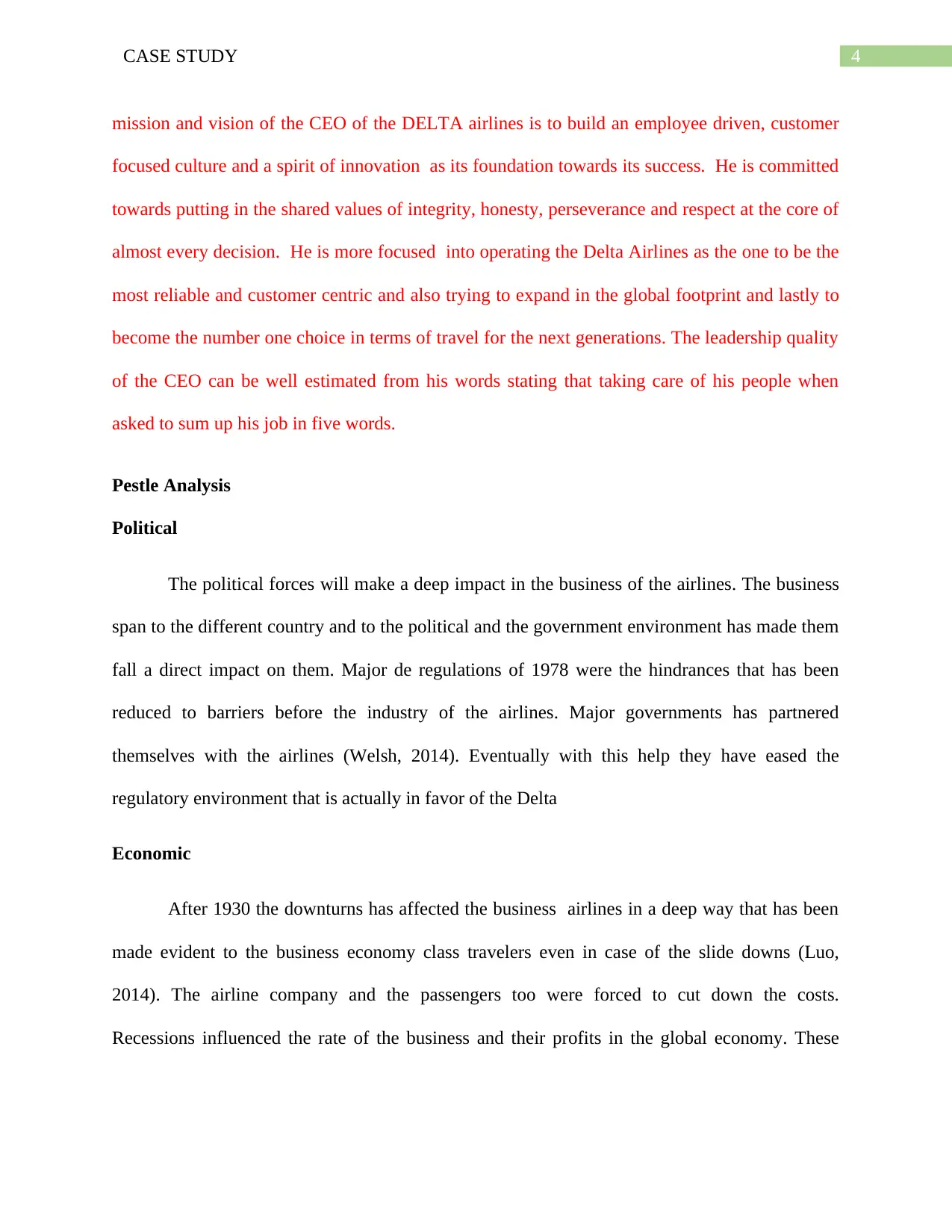
4CASE STUDY
mission and vision of the CEO of the DELTA airlines is to build an employee driven, customer
focused culture and a spirit of innovation as its foundation towards its success. He is committed
towards putting in the shared values of integrity, honesty, perseverance and respect at the core of
almost every decision. He is more focused into operating the Delta Airlines as the one to be the
most reliable and customer centric and also trying to expand in the global footprint and lastly to
become the number one choice in terms of travel for the next generations. The leadership quality
of the CEO can be well estimated from his words stating that taking care of his people when
asked to sum up his job in five words.
Pestle Analysis
Political
The political forces will make a deep impact in the business of the airlines. The business
span to the different country and to the political and the government environment has made them
fall a direct impact on them. Major de regulations of 1978 were the hindrances that has been
reduced to barriers before the industry of the airlines. Major governments has partnered
themselves with the airlines (Welsh, 2014). Eventually with this help they have eased the
regulatory environment that is actually in favor of the Delta
Economic
After 1930 the downturns has affected the business airlines in a deep way that has been
made evident to the business economy class travelers even in case of the slide downs (Luo,
2014). The airline company and the passengers too were forced to cut down the costs.
Recessions influenced the rate of the business and their profits in the global economy. These
mission and vision of the CEO of the DELTA airlines is to build an employee driven, customer
focused culture and a spirit of innovation as its foundation towards its success. He is committed
towards putting in the shared values of integrity, honesty, perseverance and respect at the core of
almost every decision. He is more focused into operating the Delta Airlines as the one to be the
most reliable and customer centric and also trying to expand in the global footprint and lastly to
become the number one choice in terms of travel for the next generations. The leadership quality
of the CEO can be well estimated from his words stating that taking care of his people when
asked to sum up his job in five words.
Pestle Analysis
Political
The political forces will make a deep impact in the business of the airlines. The business
span to the different country and to the political and the government environment has made them
fall a direct impact on them. Major de regulations of 1978 were the hindrances that has been
reduced to barriers before the industry of the airlines. Major governments has partnered
themselves with the airlines (Welsh, 2014). Eventually with this help they have eased the
regulatory environment that is actually in favor of the Delta
Economic
After 1930 the downturns has affected the business airlines in a deep way that has been
made evident to the business economy class travelers even in case of the slide downs (Luo,
2014). The airline company and the passengers too were forced to cut down the costs.
Recessions influenced the rate of the business and their profits in the global economy. These
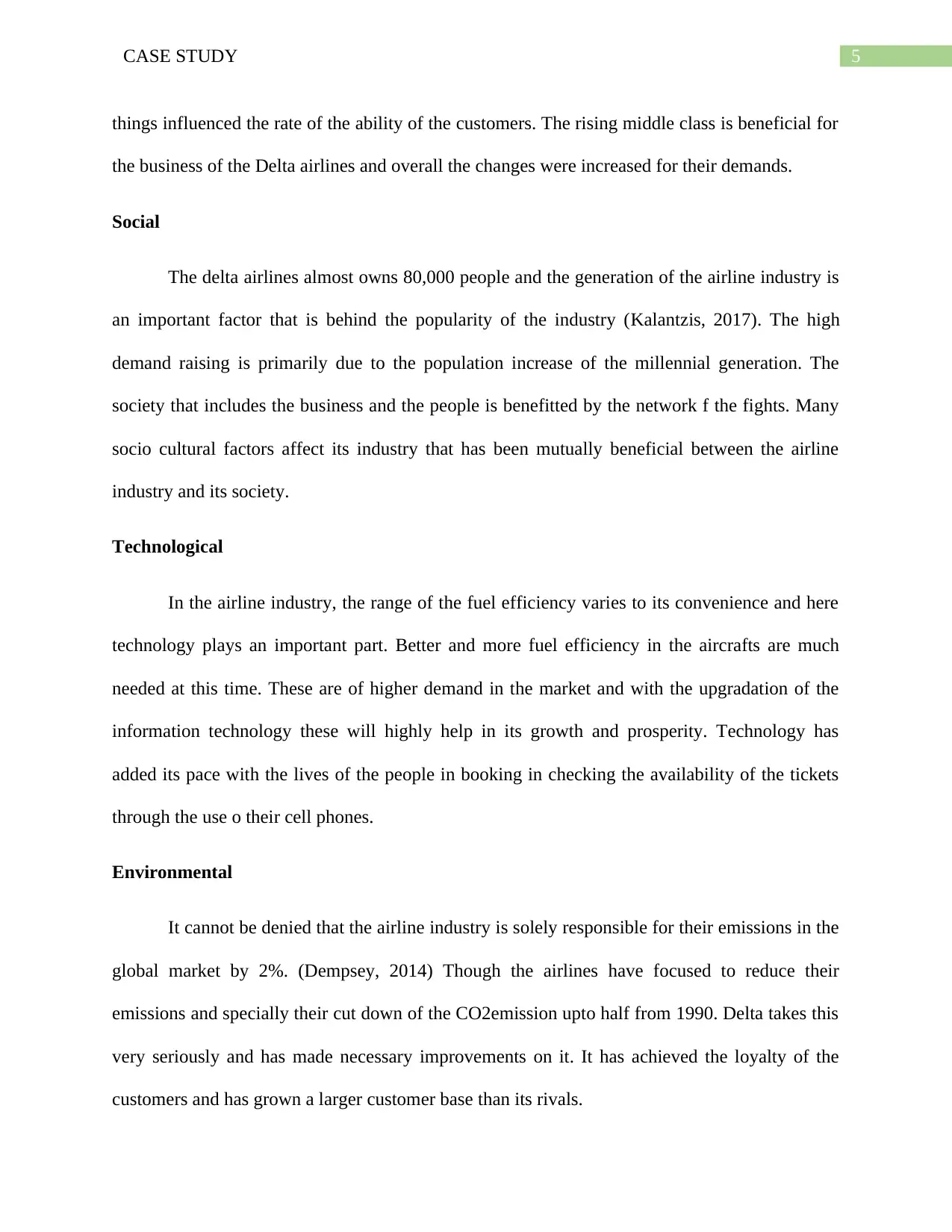
5CASE STUDY
things influenced the rate of the ability of the customers. The rising middle class is beneficial for
the business of the Delta airlines and overall the changes were increased for their demands.
Social
The delta airlines almost owns 80,000 people and the generation of the airline industry is
an important factor that is behind the popularity of the industry (Kalantzis, 2017). The high
demand raising is primarily due to the population increase of the millennial generation. The
society that includes the business and the people is benefitted by the network f the fights. Many
socio cultural factors affect its industry that has been mutually beneficial between the airline
industry and its society.
Technological
In the airline industry, the range of the fuel efficiency varies to its convenience and here
technology plays an important part. Better and more fuel efficiency in the aircrafts are much
needed at this time. These are of higher demand in the market and with the upgradation of the
information technology these will highly help in its growth and prosperity. Technology has
added its pace with the lives of the people in booking in checking the availability of the tickets
through the use o their cell phones.
Environmental
It cannot be denied that the airline industry is solely responsible for their emissions in the
global market by 2%. (Dempsey, 2014) Though the airlines have focused to reduce their
emissions and specially their cut down of the CO2emission upto half from 1990. Delta takes this
very seriously and has made necessary improvements on it. It has achieved the loyalty of the
customers and has grown a larger customer base than its rivals.
things influenced the rate of the ability of the customers. The rising middle class is beneficial for
the business of the Delta airlines and overall the changes were increased for their demands.
Social
The delta airlines almost owns 80,000 people and the generation of the airline industry is
an important factor that is behind the popularity of the industry (Kalantzis, 2017). The high
demand raising is primarily due to the population increase of the millennial generation. The
society that includes the business and the people is benefitted by the network f the fights. Many
socio cultural factors affect its industry that has been mutually beneficial between the airline
industry and its society.
Technological
In the airline industry, the range of the fuel efficiency varies to its convenience and here
technology plays an important part. Better and more fuel efficiency in the aircrafts are much
needed at this time. These are of higher demand in the market and with the upgradation of the
information technology these will highly help in its growth and prosperity. Technology has
added its pace with the lives of the people in booking in checking the availability of the tickets
through the use o their cell phones.
Environmental
It cannot be denied that the airline industry is solely responsible for their emissions in the
global market by 2%. (Dempsey, 2014) Though the airlines have focused to reduce their
emissions and specially their cut down of the CO2emission upto half from 1990. Delta takes this
very seriously and has made necessary improvements on it. It has achieved the loyalty of the
customers and has grown a larger customer base than its rivals.
⊘ This is a preview!⊘
Do you want full access?
Subscribe today to unlock all pages.

Trusted by 1+ million students worldwide
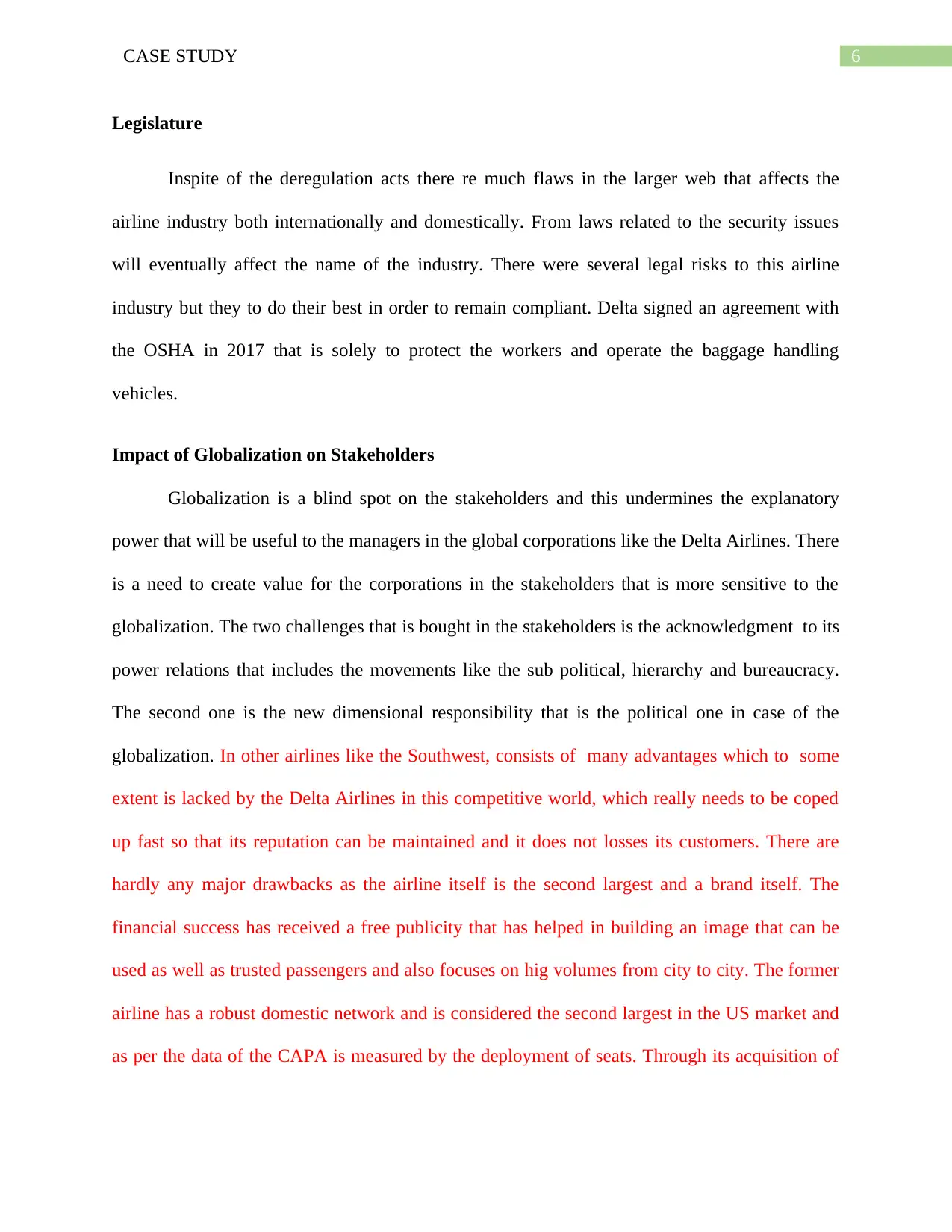
6CASE STUDY
Legislature
Inspite of the deregulation acts there re much flaws in the larger web that affects the
airline industry both internationally and domestically. From laws related to the security issues
will eventually affect the name of the industry. There were several legal risks to this airline
industry but they to do their best in order to remain compliant. Delta signed an agreement with
the OSHA in 2017 that is solely to protect the workers and operate the baggage handling
vehicles.
Impact of Globalization on Stakeholders
Globalization is a blind spot on the stakeholders and this undermines the explanatory
power that will be useful to the managers in the global corporations like the Delta Airlines. There
is a need to create value for the corporations in the stakeholders that is more sensitive to the
globalization. The two challenges that is bought in the stakeholders is the acknowledgment to its
power relations that includes the movements like the sub political, hierarchy and bureaucracy.
The second one is the new dimensional responsibility that is the political one in case of the
globalization. In other airlines like the Southwest, consists of many advantages which to some
extent is lacked by the Delta Airlines in this competitive world, which really needs to be coped
up fast so that its reputation can be maintained and it does not losses its customers. There are
hardly any major drawbacks as the airline itself is the second largest and a brand itself. The
financial success has received a free publicity that has helped in building an image that can be
used as well as trusted passengers and also focuses on hig volumes from city to city. The former
airline has a robust domestic network and is considered the second largest in the US market and
as per the data of the CAPA is measured by the deployment of seats. Through its acquisition of
Legislature
Inspite of the deregulation acts there re much flaws in the larger web that affects the
airline industry both internationally and domestically. From laws related to the security issues
will eventually affect the name of the industry. There were several legal risks to this airline
industry but they to do their best in order to remain compliant. Delta signed an agreement with
the OSHA in 2017 that is solely to protect the workers and operate the baggage handling
vehicles.
Impact of Globalization on Stakeholders
Globalization is a blind spot on the stakeholders and this undermines the explanatory
power that will be useful to the managers in the global corporations like the Delta Airlines. There
is a need to create value for the corporations in the stakeholders that is more sensitive to the
globalization. The two challenges that is bought in the stakeholders is the acknowledgment to its
power relations that includes the movements like the sub political, hierarchy and bureaucracy.
The second one is the new dimensional responsibility that is the political one in case of the
globalization. In other airlines like the Southwest, consists of many advantages which to some
extent is lacked by the Delta Airlines in this competitive world, which really needs to be coped
up fast so that its reputation can be maintained and it does not losses its customers. There are
hardly any major drawbacks as the airline itself is the second largest and a brand itself. The
financial success has received a free publicity that has helped in building an image that can be
used as well as trusted passengers and also focuses on hig volumes from city to city. The former
airline has a robust domestic network and is considered the second largest in the US market and
as per the data of the CAPA is measured by the deployment of seats. Through its acquisition of
Paraphrase This Document
Need a fresh take? Get an instant paraphrase of this document with our AI Paraphraser
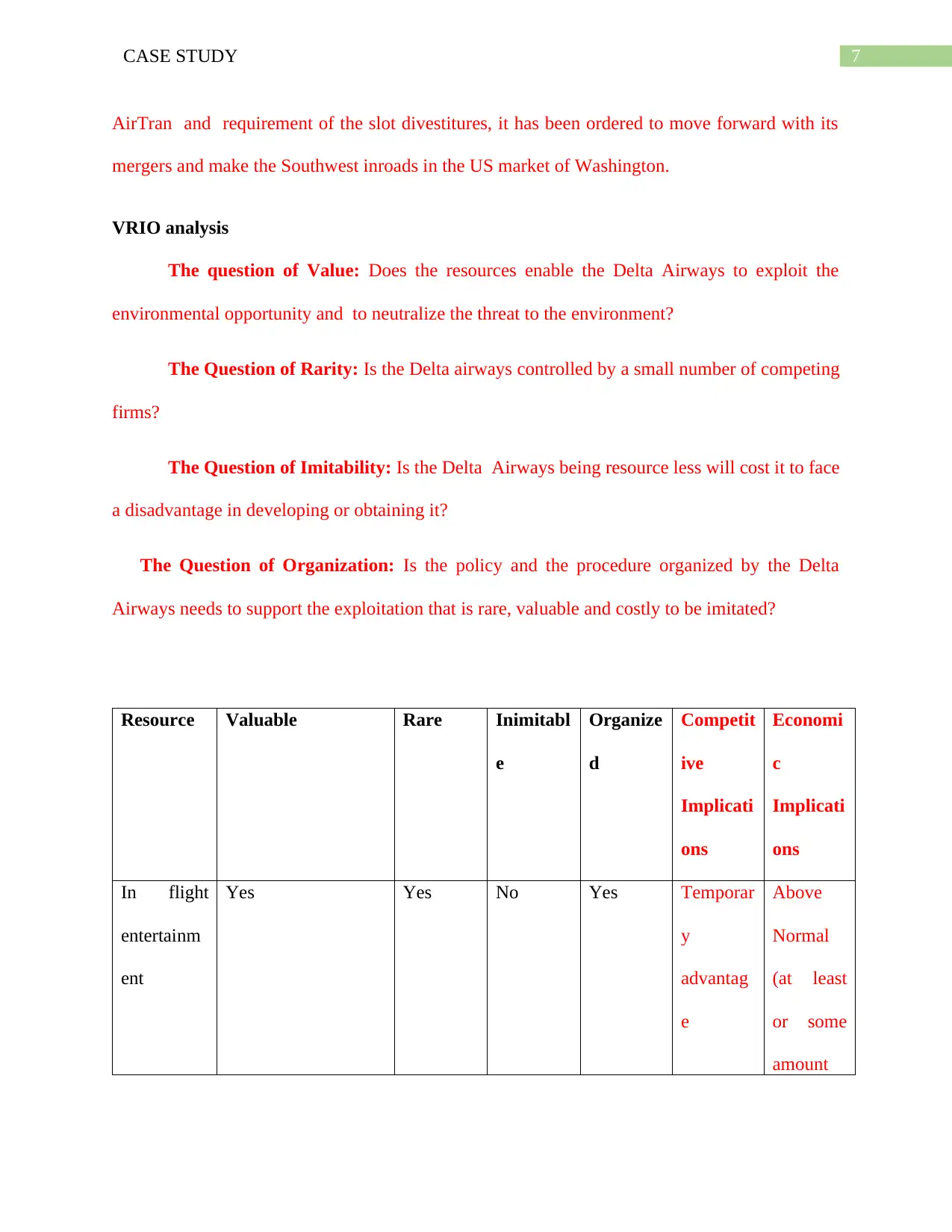
7CASE STUDY
AirTran and requirement of the slot divestitures, it has been ordered to move forward with its
mergers and make the Southwest inroads in the US market of Washington.
VRIO analysis
The question of Value: Does the resources enable the Delta Airways to exploit the
environmental opportunity and to neutralize the threat to the environment?
The Question of Rarity: Is the Delta airways controlled by a small number of competing
firms?
The Question of Imitability: Is the Delta Airways being resource less will cost it to face
a disadvantage in developing or obtaining it?
The Question of Organization: Is the policy and the procedure organized by the Delta
Airways needs to support the exploitation that is rare, valuable and costly to be imitated?
Resource Valuable Rare Inimitabl
e
Organize
d
Competit
ive
Implicati
ons
Economi
c
Implicati
ons
In flight
entertainm
ent
Yes Yes No Yes Temporar
y
advantag
e
Above
Normal
(at least
or some
amount
AirTran and requirement of the slot divestitures, it has been ordered to move forward with its
mergers and make the Southwest inroads in the US market of Washington.
VRIO analysis
The question of Value: Does the resources enable the Delta Airways to exploit the
environmental opportunity and to neutralize the threat to the environment?
The Question of Rarity: Is the Delta airways controlled by a small number of competing
firms?
The Question of Imitability: Is the Delta Airways being resource less will cost it to face
a disadvantage in developing or obtaining it?
The Question of Organization: Is the policy and the procedure organized by the Delta
Airways needs to support the exploitation that is rare, valuable and costly to be imitated?
Resource Valuable Rare Inimitabl
e
Organize
d
Competit
ive
Implicati
ons
Economi
c
Implicati
ons
In flight
entertainm
ent
Yes Yes No Yes Temporar
y
advantag
e
Above
Normal
(at least
or some
amount
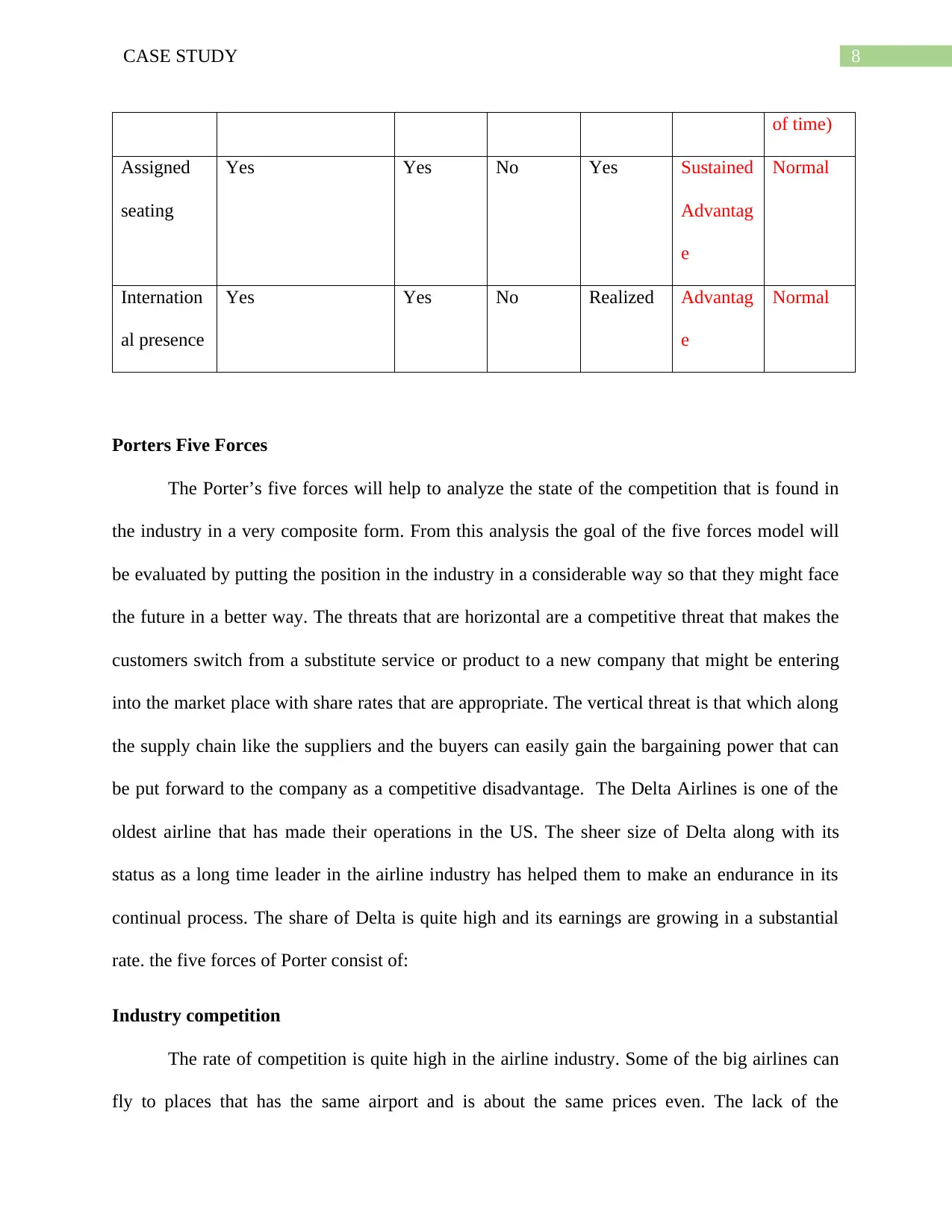
8CASE STUDY
of time)
Assigned
seating
Yes Yes No Yes Sustained
Advantag
e
Normal
Internation
al presence
Yes Yes No Realized Advantag
e
Normal
Porters Five Forces
The Porter’s five forces will help to analyze the state of the competition that is found in
the industry in a very composite form. From this analysis the goal of the five forces model will
be evaluated by putting the position in the industry in a considerable way so that they might face
the future in a better way. The threats that are horizontal are a competitive threat that makes the
customers switch from a substitute service or product to a new company that might be entering
into the market place with share rates that are appropriate. The vertical threat is that which along
the supply chain like the suppliers and the buyers can easily gain the bargaining power that can
be put forward to the company as a competitive disadvantage. The Delta Airlines is one of the
oldest airline that has made their operations in the US. The sheer size of Delta along with its
status as a long time leader in the airline industry has helped them to make an endurance in its
continual process. The share of Delta is quite high and its earnings are growing in a substantial
rate. the five forces of Porter consist of:
Industry competition
The rate of competition is quite high in the airline industry. Some of the big airlines can
fly to places that has the same airport and is about the same prices even. The lack of the
of time)
Assigned
seating
Yes Yes No Yes Sustained
Advantag
e
Normal
Internation
al presence
Yes Yes No Realized Advantag
e
Normal
Porters Five Forces
The Porter’s five forces will help to analyze the state of the competition that is found in
the industry in a very composite form. From this analysis the goal of the five forces model will
be evaluated by putting the position in the industry in a considerable way so that they might face
the future in a better way. The threats that are horizontal are a competitive threat that makes the
customers switch from a substitute service or product to a new company that might be entering
into the market place with share rates that are appropriate. The vertical threat is that which along
the supply chain like the suppliers and the buyers can easily gain the bargaining power that can
be put forward to the company as a competitive disadvantage. The Delta Airlines is one of the
oldest airline that has made their operations in the US. The sheer size of Delta along with its
status as a long time leader in the airline industry has helped them to make an endurance in its
continual process. The share of Delta is quite high and its earnings are growing in a substantial
rate. the five forces of Porter consist of:
Industry competition
The rate of competition is quite high in the airline industry. Some of the big airlines can
fly to places that has the same airport and is about the same prices even. The lack of the
⊘ This is a preview!⊘
Do you want full access?
Subscribe today to unlock all pages.

Trusted by 1+ million students worldwide
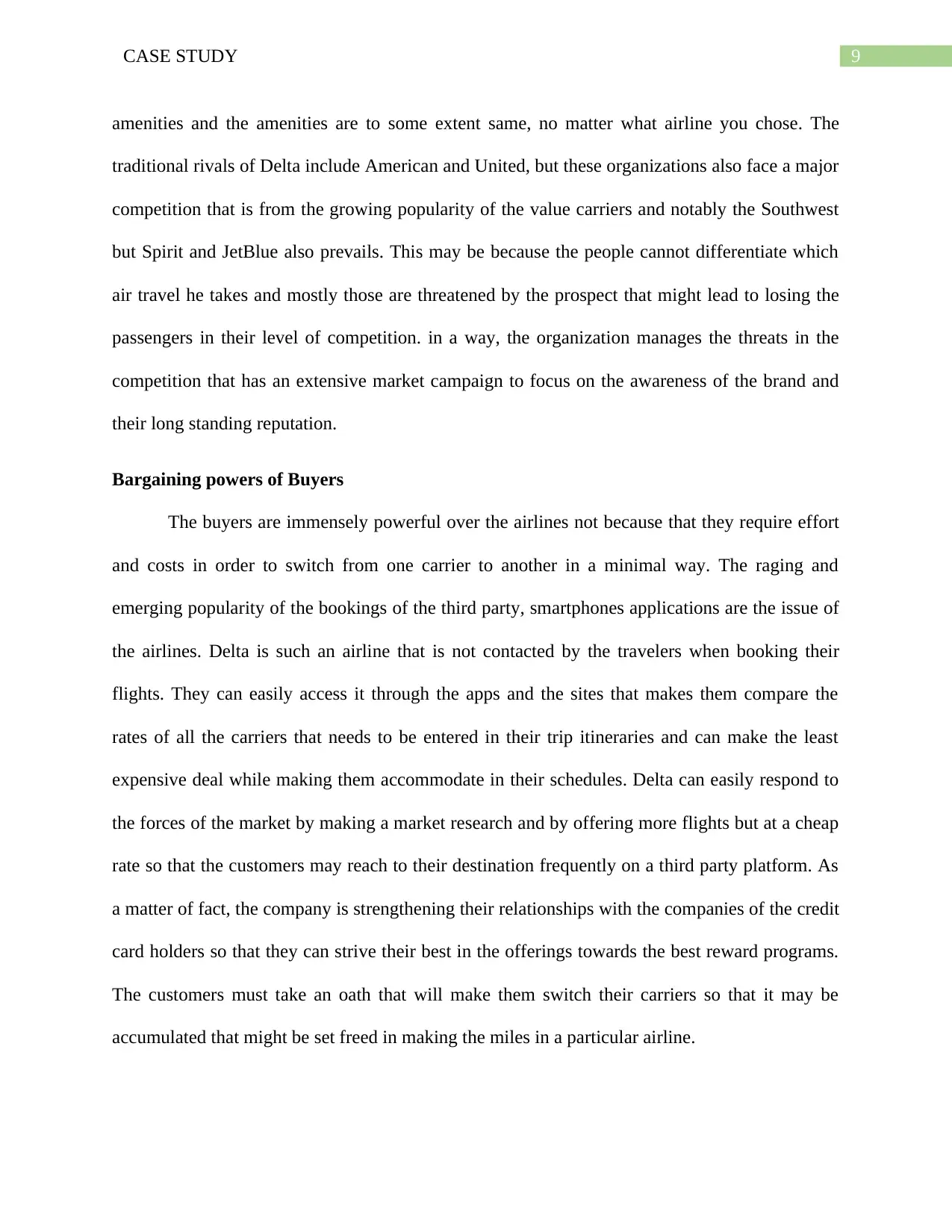
9CASE STUDY
amenities and the amenities are to some extent same, no matter what airline you chose. The
traditional rivals of Delta include American and United, but these organizations also face a major
competition that is from the growing popularity of the value carriers and notably the Southwest
but Spirit and JetBlue also prevails. This may be because the people cannot differentiate which
air travel he takes and mostly those are threatened by the prospect that might lead to losing the
passengers in their level of competition. in a way, the organization manages the threats in the
competition that has an extensive market campaign to focus on the awareness of the brand and
their long standing reputation.
Bargaining powers of Buyers
The buyers are immensely powerful over the airlines not because that they require effort
and costs in order to switch from one carrier to another in a minimal way. The raging and
emerging popularity of the bookings of the third party, smartphones applications are the issue of
the airlines. Delta is such an airline that is not contacted by the travelers when booking their
flights. They can easily access it through the apps and the sites that makes them compare the
rates of all the carriers that needs to be entered in their trip itineraries and can make the least
expensive deal while making them accommodate in their schedules. Delta can easily respond to
the forces of the market by making a market research and by offering more flights but at a cheap
rate so that the customers may reach to their destination frequently on a third party platform. As
a matter of fact, the company is strengthening their relationships with the companies of the credit
card holders so that they can strive their best in the offerings towards the best reward programs.
The customers must take an oath that will make them switch their carriers so that it may be
accumulated that might be set freed in making the miles in a particular airline.
amenities and the amenities are to some extent same, no matter what airline you chose. The
traditional rivals of Delta include American and United, but these organizations also face a major
competition that is from the growing popularity of the value carriers and notably the Southwest
but Spirit and JetBlue also prevails. This may be because the people cannot differentiate which
air travel he takes and mostly those are threatened by the prospect that might lead to losing the
passengers in their level of competition. in a way, the organization manages the threats in the
competition that has an extensive market campaign to focus on the awareness of the brand and
their long standing reputation.
Bargaining powers of Buyers
The buyers are immensely powerful over the airlines not because that they require effort
and costs in order to switch from one carrier to another in a minimal way. The raging and
emerging popularity of the bookings of the third party, smartphones applications are the issue of
the airlines. Delta is such an airline that is not contacted by the travelers when booking their
flights. They can easily access it through the apps and the sites that makes them compare the
rates of all the carriers that needs to be entered in their trip itineraries and can make the least
expensive deal while making them accommodate in their schedules. Delta can easily respond to
the forces of the market by making a market research and by offering more flights but at a cheap
rate so that the customers may reach to their destination frequently on a third party platform. As
a matter of fact, the company is strengthening their relationships with the companies of the credit
card holders so that they can strive their best in the offerings towards the best reward programs.
The customers must take an oath that will make them switch their carriers so that it may be
accumulated that might be set freed in making the miles in a particular airline.
Paraphrase This Document
Need a fresh take? Get an instant paraphrase of this document with our AI Paraphraser
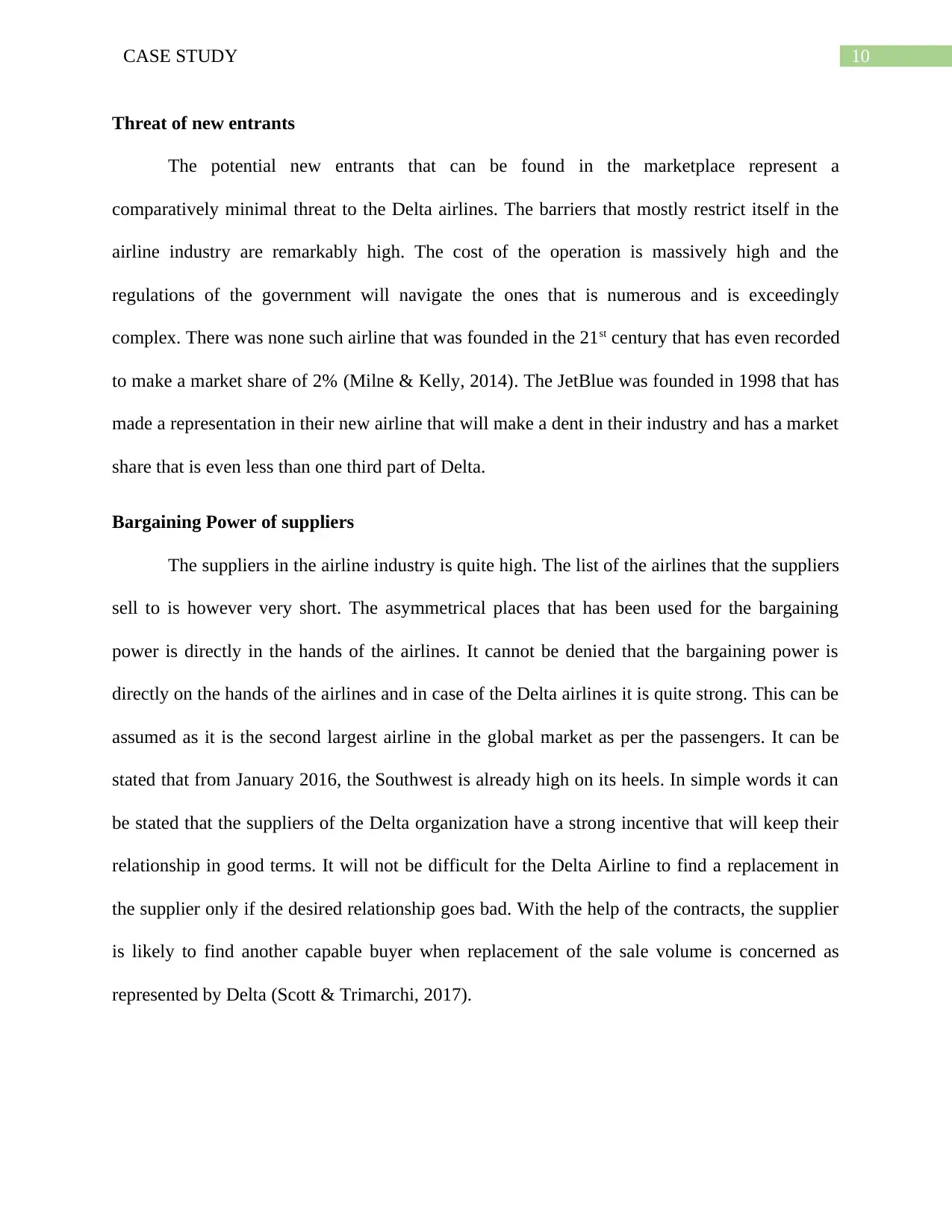
10CASE STUDY
Threat of new entrants
The potential new entrants that can be found in the marketplace represent a
comparatively minimal threat to the Delta airlines. The barriers that mostly restrict itself in the
airline industry are remarkably high. The cost of the operation is massively high and the
regulations of the government will navigate the ones that is numerous and is exceedingly
complex. There was none such airline that was founded in the 21st century that has even recorded
to make a market share of 2% (Milne & Kelly, 2014). The JetBlue was founded in 1998 that has
made a representation in their new airline that will make a dent in their industry and has a market
share that is even less than one third part of Delta.
Bargaining Power of suppliers
The suppliers in the airline industry is quite high. The list of the airlines that the suppliers
sell to is however very short. The asymmetrical places that has been used for the bargaining
power is directly in the hands of the airlines. It cannot be denied that the bargaining power is
directly on the hands of the airlines and in case of the Delta airlines it is quite strong. This can be
assumed as it is the second largest airline in the global market as per the passengers. It can be
stated that from January 2016, the Southwest is already high on its heels. In simple words it can
be stated that the suppliers of the Delta organization have a strong incentive that will keep their
relationship in good terms. It will not be difficult for the Delta Airline to find a replacement in
the supplier only if the desired relationship goes bad. With the help of the contracts, the supplier
is likely to find another capable buyer when replacement of the sale volume is concerned as
represented by Delta (Scott & Trimarchi, 2017).
Threat of new entrants
The potential new entrants that can be found in the marketplace represent a
comparatively minimal threat to the Delta airlines. The barriers that mostly restrict itself in the
airline industry are remarkably high. The cost of the operation is massively high and the
regulations of the government will navigate the ones that is numerous and is exceedingly
complex. There was none such airline that was founded in the 21st century that has even recorded
to make a market share of 2% (Milne & Kelly, 2014). The JetBlue was founded in 1998 that has
made a representation in their new airline that will make a dent in their industry and has a market
share that is even less than one third part of Delta.
Bargaining Power of suppliers
The suppliers in the airline industry is quite high. The list of the airlines that the suppliers
sell to is however very short. The asymmetrical places that has been used for the bargaining
power is directly in the hands of the airlines. It cannot be denied that the bargaining power is
directly on the hands of the airlines and in case of the Delta airlines it is quite strong. This can be
assumed as it is the second largest airline in the global market as per the passengers. It can be
stated that from January 2016, the Southwest is already high on its heels. In simple words it can
be stated that the suppliers of the Delta organization have a strong incentive that will keep their
relationship in good terms. It will not be difficult for the Delta Airline to find a replacement in
the supplier only if the desired relationship goes bad. With the help of the contracts, the supplier
is likely to find another capable buyer when replacement of the sale volume is concerned as
represented by Delta (Scott & Trimarchi, 2017).
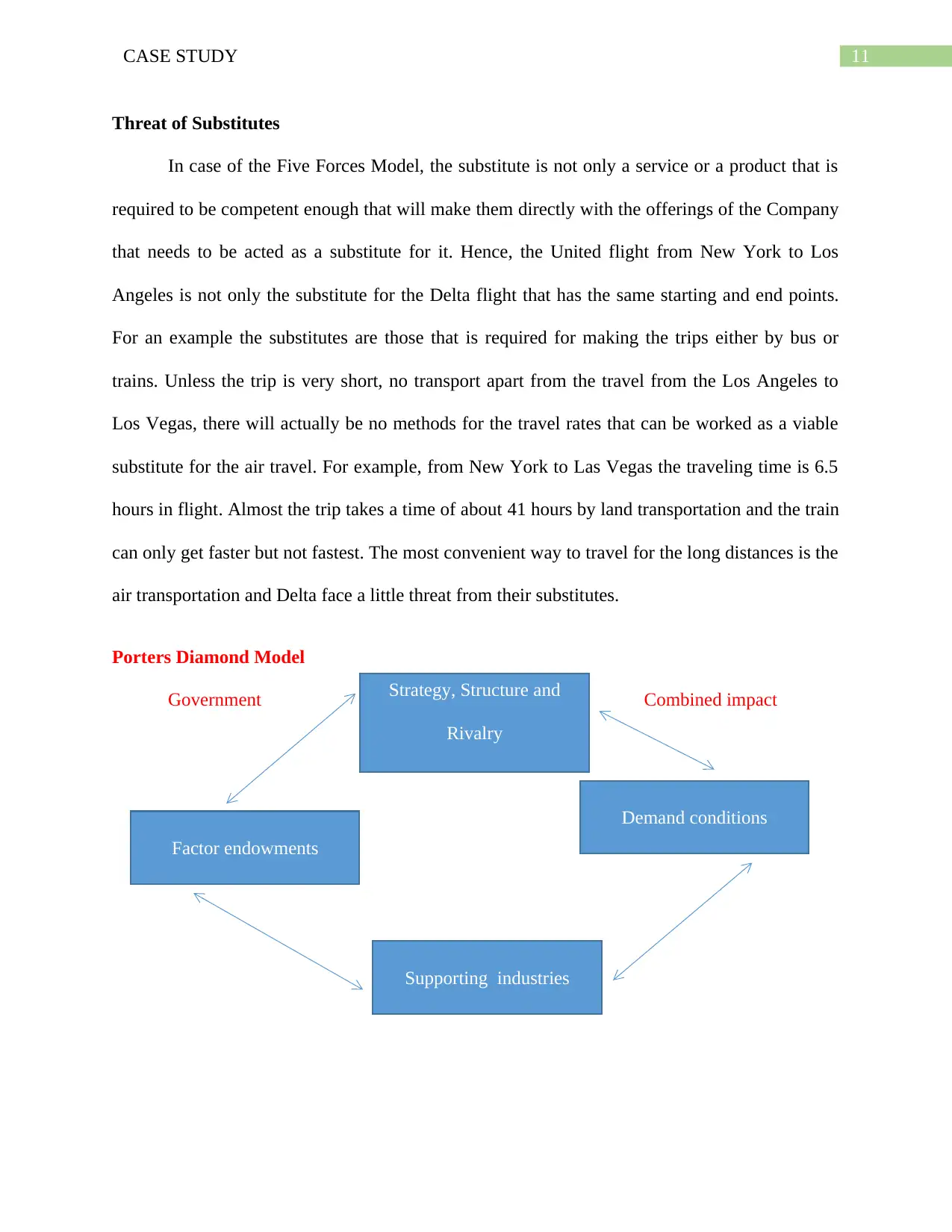
11CASE STUDY
Threat of Substitutes
In case of the Five Forces Model, the substitute is not only a service or a product that is
required to be competent enough that will make them directly with the offerings of the Company
that needs to be acted as a substitute for it. Hence, the United flight from New York to Los
Angeles is not only the substitute for the Delta flight that has the same starting and end points.
For an example the substitutes are those that is required for making the trips either by bus or
trains. Unless the trip is very short, no transport apart from the travel from the Los Angeles to
Los Vegas, there will actually be no methods for the travel rates that can be worked as a viable
substitute for the air travel. For example, from New York to Las Vegas the traveling time is 6.5
hours in flight. Almost the trip takes a time of about 41 hours by land transportation and the train
can only get faster but not fastest. The most convenient way to travel for the long distances is the
air transportation and Delta face a little threat from their substitutes.
Porters Diamond Model
Government Combined impact
Strategy, Structure and
Rivalry
Demand conditions
Supporting industries
Factor endowments
Threat of Substitutes
In case of the Five Forces Model, the substitute is not only a service or a product that is
required to be competent enough that will make them directly with the offerings of the Company
that needs to be acted as a substitute for it. Hence, the United flight from New York to Los
Angeles is not only the substitute for the Delta flight that has the same starting and end points.
For an example the substitutes are those that is required for making the trips either by bus or
trains. Unless the trip is very short, no transport apart from the travel from the Los Angeles to
Los Vegas, there will actually be no methods for the travel rates that can be worked as a viable
substitute for the air travel. For example, from New York to Las Vegas the traveling time is 6.5
hours in flight. Almost the trip takes a time of about 41 hours by land transportation and the train
can only get faster but not fastest. The most convenient way to travel for the long distances is the
air transportation and Delta face a little threat from their substitutes.
Porters Diamond Model
Government Combined impact
Strategy, Structure and
Rivalry
Demand conditions
Supporting industries
Factor endowments
⊘ This is a preview!⊘
Do you want full access?
Subscribe today to unlock all pages.

Trusted by 1+ million students worldwide
1 out of 21
Related Documents
Your All-in-One AI-Powered Toolkit for Academic Success.
+13062052269
info@desklib.com
Available 24*7 on WhatsApp / Email
![[object Object]](/_next/static/media/star-bottom.7253800d.svg)
Unlock your academic potential
Copyright © 2020–2025 A2Z Services. All Rights Reserved. Developed and managed by ZUCOL.





